
Pinus nigra, the Austrian pine or black pine, is a moderately variable species of pine, occurring across Southern Europe from the Iberian Peninsula to the eastern Mediterranean, on the Anatolian peninsula of Turkey, Corsica and Cyprus, as well as Crimea and in the high mountains of Northwest Africa.

Pinus halepensis, commonly known as the Aleppo pine, also known as the Jerusalem pine, is a pine native to the Mediterranean region.
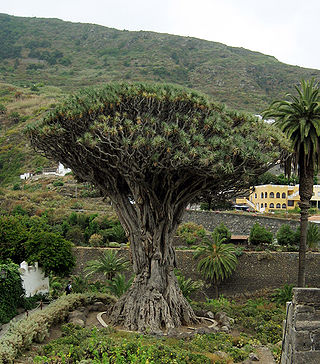
Dracaena draco, the Canary Islands dragon tree or drago, is a subtropical tree in the genus Dracaena, native to the Canary Islands, Cape Verde, Madeira, western Morocco, and is thought to be introduced in the Azores. Its closest living relative is the dragon blood tree of Socotra, Dracaena cinnabari.

Ras Nouadhibou is a 60-kilometre (37 mi) peninsula or headland divided by the border between Mauritania and Western Sahara on the African coast of the Atlantic Ocean. It is internationally known as Cabo Blanco in Spanish or Cap Blanc in French.
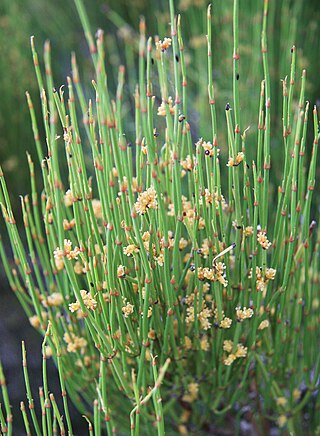
Ephedra is a genus of gymnosperm shrubs. The various species of Ephedra are widespread in many arid regions of the world, ranging across southwestern North America, southern Europe, northern Africa, southwest and central Asia, northern China and western South America. It is the only extant genus in its family, Ephedraceae, and order, Ephedrales, and one of the three living members of the division Gnetophyta alongside Gnetum and Welwitschia.
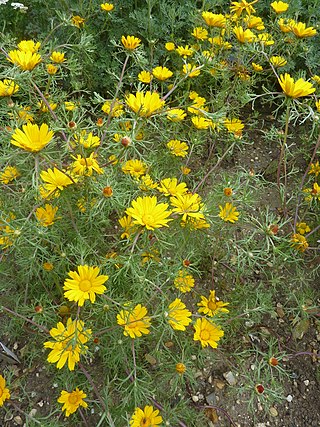
Cladanthus is a genus of plants in the sunflower family, native to the Mediterranean region.
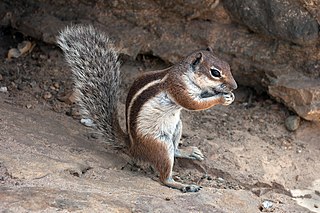
The Barbary ground squirrel is a species of rodent in the family Sciuridae. It is monotypic within the genus Atlantoxerus. It is endemic to the Atlas mountains in Morocco and some parts in Algeria, and has been introduced into the Canary Islands. Its natural habitats are subtropical or tropical dry shrubland, temperate grassland and rocky areas where it lives colonially in burrows. It was first described by Carl Linnaeus in his landmark 1758 10th edition of Systema Naturae.
Ephedra alata is a species of Ephedra. These plants are perennial and xerophytic gymnosperm shrubs.
Ephedra przewalskii is a species of Ephedra that is native to Central Asia, Mongolia, Pakistan, and parts of China.

Ephedra strobilacea is a species of Ephedra that is native to Iran and Central Asia.
Ephedra multiflora is a species of Ephedra that is native to northern Chile and Northwest Argentina.

Ephedra torreyana, with common names Torrey's jointfir or Torrey's Mormon tea, is a species of Ephedra that is native to the deserts and scrublands of the Southwestern United States and to the State of Chihuahua and northern Mexico.

Ephedra altissima is a species of Ephedra that is native to the western Sahara, and also to the Canary Islands.
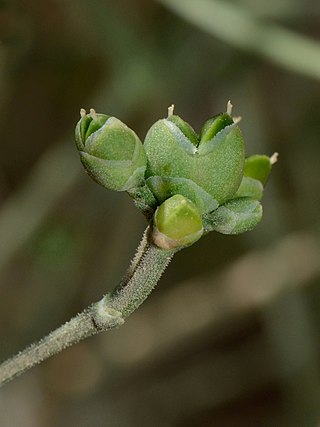
Ephedra foliata is a species of gymnosperm in the Ephedraceae family. It is referred to by the common name shrubby horsetail. It is native to North Africa, and Southwest Asia, from Morocco and Mauritania east to Turkmenistan, Pakistan, and Punjab State in India.
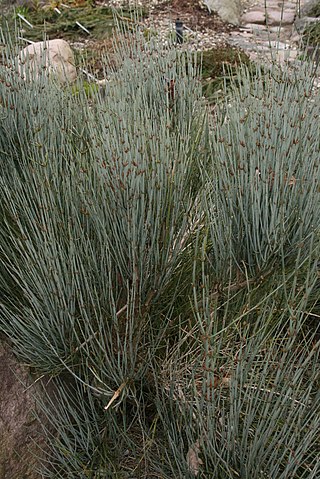
Ephedra intermedia, with the Chinese common name of Zhong Ma Huang, is a species of Ephedra that is native to Siberia, Central Asia, Iran, Afghanistan, Pakistan, the western Himalayas, Tibet, Mongolia, and China.
Tricholaena is a genus of Asian, African, and Italian plants in the grass family.

Spilostethus pandurus is a species of "seed bugs" belonging to the family Lygaeidae, subfamily Lygaeinae.

Patellifolia is a genus of flowering plants in the subfamily Betoideae of the family Amaranthaceae. These are mostly procumbent herbs occurring in the Western Mediterranean region and Macaronesia, with some isolated occurrences in North Africa and at the Horn of Africa. They are interesting as crop wild relatives of sugar beet.

Euphorbia regis-jubae is a species of flowering plant in the family Euphorbiaceae, native to the eastern Canary Islands, western Morocco, north-western Western Sahara. In Spanish, it is known as tabaiba morisca. It has often been confused with Euphorbia lamarckii.

Salix pedicellata is a species of willow. It is a shrub or small tree to about 6–8 m tall, native around the Mediterranean Sea from Portugal to Lebanon and Syria in the north and from the Canary Islands to Tunisia in the south. Salix canariensis may be treated as a subspecies of S. pedicellata.
















